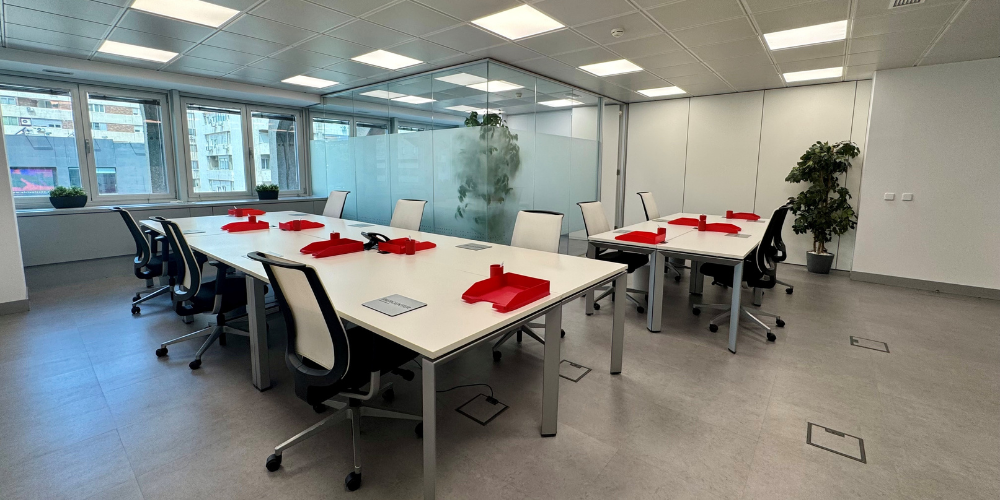Discover the usefulness of an elevator pitch for your business
Imagine you step into a lift and, just as the doors close, you meet the person who could change the future of your business. You have just a few seconds to grab their attention, pique their interest and make them want to keep listening to you. That, in essence, is an elevator pitch: a short, clear and persuasive presentation that condenses the essence of your idea into the time it takes for a lift ride.
In the business world, the ability to communicate accurately and make an impact in a matter of seconds is a key skill. Whether you are looking for investors, clients or strategic partners, your elevator pitch can make the difference between a missed opportunity and the start of a promising professional relationship. It’s not just about what you say, but how you say it. You need to convey confidence, enthusiasm and clarity in a direct message that leaves an impression.
Throughout this article, we will explore how to construct an effective elevator pitch, what are the most common mistakes to avoid and how to tailor your speech to suit the occasion. Whether you have a business idea, an innovative product or a service you want to highlight, perfecting your elevator pitch is the first step to get others to see it with the same enthusiasm with which you envision it.

What is an elevator pitch?
An elevator pitch is a quick and effective presentation that allows you to sell an idea, a business or even yourself in a matter of seconds. It is a short, clear and persuasive speech designed to capture the attention of a potential investor, client or partner in the shortest possible time. It is not just about summarising a proposal, but about generating interest, arousing curiosity and making the other person want to know more.
The term elevator pitch originates from the image of an entrepreneur who meets a senior executive in a lift and only has the time it takes to explain his or her project. In the business world, where opportunities are fleeting and competition is fierce, mastering this technique is key to standing out. It is no coincidence that many startups invest time in perfecting their elevator pitch, as it can make the difference between getting funding or going unnoticed.
There are many situations where an elevator pitch is the perfect tool to make an impact. An entrepreneur who attends a networking event and has just a few minutes to capture the attention of an investor. A professional who, in a coworking space in Madrid, comes across a potential client and needs to explain clearly and directly how they can help them. A salesperson who has only a few moments to present a product to a potential buyer. In all these cases, a well-structured and convincing speech can open doors that would otherwise remain closed.
In an environment where every second counts, knowing how to communicate accurately and persuasively is more important than ever. A good elevator pitch not only helps sell an idea but also builds opportunities and strengthens the personal or business brand.
Essential elements of a good elevator pitch
An effective elevator pitch is much more than just a quick presentation of an idea or business. It is a strategic tool that must be carefully designed to capture attention in seconds and generate immediate interest. To really work, it must meet four essential elements: clarity, brevity, impact and a compelling call to action.
Clarity is the foundation of any elevator pitch. If the listener doesn’t understand what you’re offering in a matter of seconds, you’ve lost a valuable opportunity. It is essential to use simple and direct language, avoiding unnecessary technicalities. It should be possible to explain your idea in a way that anyone, even without prior knowledge of the sector, can quickly understand what it is about and why it is relevant.
Brevity is another fundamental pillar. An elevator pitch should last between 30 and 60 seconds, just long enough to arouse interest without overwhelming with too much information. In this time, you must convey the essentials: who you are, what you do, what problem you solve and why you are the best choice. The key is to eliminate any superfluous information and focus on what is important.
Impact is what differentiates a forgettable elevator pitch from one that leaves an impression. The first sentence should be powerful enough to grab attention immediately. It can be a surprising fact, an intriguing question or a powerful statement that makes the listener want to keep listening. It’s not just about talking, but about generating an emotional or intellectual connection with the person on the other end.
Finally, the call to action is the step that turns a good elevator pitch into a real opportunity. It is not enough to explain an idea; you must guide the interlocutor to the next step. This could be arranging a meeting, exchanging contacts or even demonstrating the product or service. Without a clear action, the message can remain in the air without generating any results.
A well-constructed elevator pitch can open doors in any professional environment. Whether in a meeting with investors, a networking event or a casual conversation in a professional environment, such as coworking spaces, knowing how to communicate with clarity, brevity and impact is a skill that can make the difference between success and oblivion.
Steps to constructing the perfect elevator pitch
Constructing the perfect elevator pitch is not a matter of improvisation, but of strategy. The key is to find the right balance between clarity, impact and conciseness so that, in a matter of seconds, your message captures attention and generates interest. To achieve this, it is essential to follow four key steps that will help you structure your speech in an effective and convincing way.
The first step is to identify your value proposition. Before you start writing your elevator pitch, you must be clear about what makes your idea, business or service special. What problem do you solve? Why are you different from the competition? What benefit does your interlocutor get if he or she decides to bet on you? If you cannot answer these questions in a simple way, your message will lose strength and will hardly generate interest.
The second step is to define your target audience. It is not the same to present an elevator pitch to an investor as it is to a potential client or a future partner. Each audience has different needs, expectations and priorities, so you must adapt your speech according to who is listening to you. Knowing who you are addressing will allow you to emphasise the most relevant aspects of your proposal and connect better with your interlocutor.
Once you know what you are going to say and who you are going to say it to, it is time to write a short and powerful version of your elevator pitch. The key here is to condense all the information into a 30-60 second speech that is clear, direct and compelling. You should structure it in such a way that the first sentence captures attention, the next sentence explains the value of your proposal, and the last sentence closes with a call to action that invites you to continue the conversation.
The last step is to practice and perfect your pitch until it sounds natural. The difference between an effective elevator pitch and a mediocre one lies in the confidence with which you deliver it. It’s not enough to memorise it, you have to internalise it and adapt it to the situation. Rehearse in front of a mirror, record yourself on video, present it in front of colleagues or even take advantage of professional environments, for which it may be interesting to rent rooms in Madrid, to test it in real situations. The more you practice, the more fluent and convincing your message will be.
Mastering the elevator pitch will not only help you sell your idea better but will also open doors in any professional context. With a well-structured, clear and persuasive message, you’ll be ready to take advantage of any opportunity that comes your way, no matter when or where it arises.
Common mistakes when making an elevator pitch
One of the biggest mistakes when making an elevator pitch is to use excessively technical language or, on the contrary, to be too ambiguous. If your interlocutor does not understand what you are saying in the first few seconds, you will lose their attention immediately. An elevator pitch is not a detailed report or an academic presentation, it is a clear and direct message that anyone should understand instantly. The trick is to explain your idea in simple words, avoiding unnecessary jargon and making sure the message is accessible to all audiences. If you have to explain too much, your elevator pitch is not well structured.
Another common failure is not conveying enthusiasm. You can have the best idea in the world, but if you present it in a monotone or without energy, you will hardly convince anyone. The elevator pitch is not only about what you say, but how you say it. The way you speak, your body language and your attitude play a crucial role in the perception you generate. Passion is contagious and, if you really believe in what you are saying, it will be much easier for your interlocutor to do so too. The key is to find a balance between confidence and naturalness, without falling into exaggerations that may seem forced.
Lack of personalisation according to the context is another of the big mistakes that can ruin an elevator pitch. You cannot use the same speech with an investor as with a potential client or a strategic partner. Each audience has different expectations and needs, so your message must be tailored to each situation. It is essential to research who you are targeting, understand what they are interested in and adjust your pitch accordingly. A generic elevator pitch rarely generates impact, while one tailored to the speaker has a much better chance of success.
To avoid these mistakes, the best strategy is to rehearse and test your elevator pitch in different environments, such as networking events or even coworking spaces, where you can get immediate feedback from other professionals. The more you practice and adjust your pitch, the more effective it will be and the more likely it will turn into a real business opportunity.
Conclusion
Mastering an elevator pitch is not a matter of luck, but of practice. No matter how good an idea is, if you don’t know how to communicate it clearly, briefly and convincingly, opportunities slip away. A good elevator pitch should sound natural, without sounding forced or over-rehearsed. The only way to achieve this is to repeat it repeatedly until it becomes part of your regular speech, allowing it to flow confidently and spontaneously in any situation.
To know if an elevator pitch is effective, it is essential to gauge the reaction of the interlocutor. If the other person shows interest, asks questions or wants to know more, it means that the message has been well conveyed. If, on the other hand, their response is vague or they change the subject quickly, it is a sign that the elevator pitch needs to be adjusted. There is no single, definitive version; every conversation is an opportunity to refine and adapt it to the audience you are addressing.
A key trick to making a lasting impression is to close the elevator pitch with a concrete action. It is not enough to blurt out information and wait for the other person to take the initiative. You need to guide the conversation to the next step, whether it’s a meeting, a call or even a simple exchange of contact. In professional environments where connections are key, having a well-prepared elevator pitch can make the difference between remaining a simple conversation or opening a real business opportunity.
Ultimately, a successful elevator pitch is the result of practice, observation and constant improvement. It’s not just about talking, it’s about connecting, convincing and leaving a mark in the listener’s mind.
Business centre in Madrid | Flexible offices in Madrid



